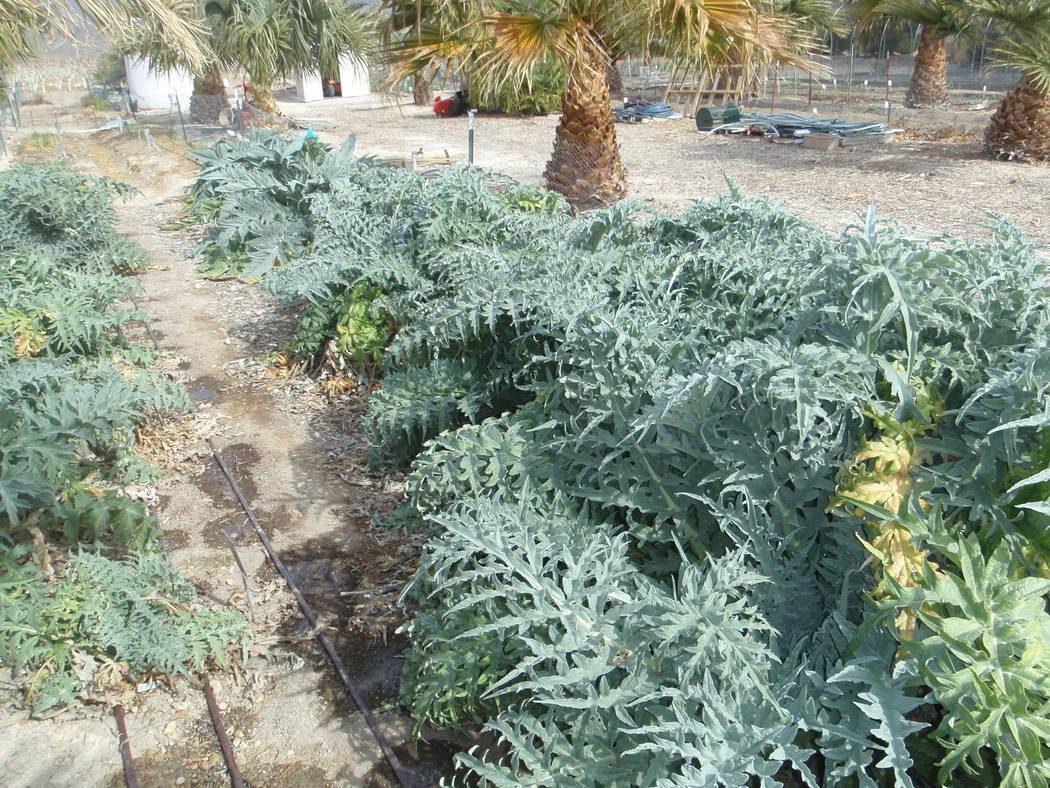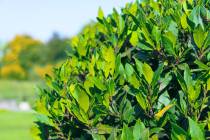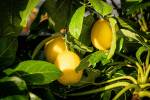Shaded leaves can pull nutrients, energy from plant
Q: I cut the lower leaves off my artichoke plant a couple months ago per your suggestion. In fact, my son, who is a pretty good gardener, asked why I cut them off. He comes over and helps me with the vegetables and asked me why I did that.
A: Educate your son and tell him that not all leaves contribute back to the plant. If the leaves are in too much shade, they pull nutrients and energy from the plant, and it’s best if they are removed.
This can be the reason lower leaves turn yellow and die. We see this frequently when plants are grown too close together. Over time, shading causes the lower, shaded leaves to become weak, die and drop.
Removing lower leaves also helps control pests. Often, the highest concentration of plant pests is on the undersides of leaves closest to the soil, where there is higher humidity, cooler temperatures and more protection from predators.
As vegetables get bigger, cut the lower leaves off the plant with scissors while still young. If spraying a pesticide is necessary to control some insects, it’s much easier to spray the undersides of leaves with lower leaves removed.
When using organic sprays such as neem oil or soap and water, they must be applied when plant pest populations are small and building, with fewer adults and mostly immature pests. Frequent applications of organic sprays are often necessary to keep plant pests in check.
Q: Can I plant fig trees in the fall, or should I wait to buy these trees in the spring?
A: Plant in the fall. Fall is the best time to plant all fruit trees, including figs. The problem is finding varieties of fruit trees that you want. But if you find the tree you want, if it is not sensitive to freezing temperatures, plant it. Figs handle temperatures down to about 10 degrees F.
The best time for planting freeze-tolerant plants is in the fall. Begin planting as temperatures cool from the summer heat. In Las Vegas, this is toward the end of September through the middle of November.
All the fig varieties grow well in the Mojave Desert if the soil is improved at the time of planting, they get enough water and it is delivered at the right time.
Q: I asked you before about tiny black bugs on my artichoke plant. After consulting you and the PC, I found a solution of neem oil extract from Garden Safe and sprayed it, hosed it down a couple times and cut off the top few inches. No pests since then. The main plant is dying, and there are several suckers growing from the sides. I have been looking online for care of the plant.
A: I never found neem oil very effective for insect control. Others have. I am glad you found a name brand that works for you. Neem oil is a “natural” pesticide, sometimes labeled organic, that has had some problems with quality control.
The effectiveness of neem oil apparently is dependent on how it is extracted or manufactured. Some brands of neem oil work well, while others seemingly do not. It sounds like Garden Safe brand may be a good one for you. Let’s hope it stays that way.
Artichokes, like sunflowers, are aphid magnets. Those little black bugs were probably aphids, commonly found on the underside of artichoke leaves.
Aphids are easy to control when they first appear. If left alone, they are not. Once populations build to epidemic numbers, they are difficult to get under control with natural or organic sprays.
Neem oil must contact the pest to be effective. It requires frequent, repeat applications when populations are small to keep levels of these pests manageable.
Aphids don’t like hot temperatures. Their populations build fastest in the cooler, darker, more humid areas near the soil. This also is where they are more difficult to see. Removing infested leaves helps reduce aphid populations.
Artichokes produce OK in our hot desert climate during the cooler months but suffer during the heat of the summer. Artichokes here tend to be smaller and a little tougher, not the same quality as those produced in cooler, more humid climates.
Artichokes love the cooler spring and fall months. They grow back quite nicely in the fall after suffering during the heat of our very hot summers. Fertilize them just before new growth begins.
Q: My tree is sending out shoots all around the trunk about one-third of its height. Is there anything I should do to help the tree?
A: The tree has been girdled around the trunk, and the trunk responded by suckering just below the damaged area.
Look closely at the trunk, just above the sprouts. You will see that the bark and sapwood have been removed all the way down to the dead inner core (wood). In other words, the tree trunk has been damaged beyond repair.
When both the xylem and phloem, aka sapwood, have been removed, the top of the tree usually dies quickly. It looks like this tree did not. This means the outer phloem has been removed, but some of the xylem still remains.
The xylem is mostly responsible for transporting water up the tree to the leaves, through the trunk and stems, from the roots. The phloem, on the other hand, is mostly responsible for transporting sugars and starches from the leaves and stems downward toward the roots. Starches are stored in the trunk, roots and limbs.
With the loss of the phloem, the tree trunk beneath this damage will no longer get any of the benefits from the green leaves. However, with some of the xylem present, water from the roots is still pushed up towards the leaves, keeping the top from dying.
If the tree does not die outright, it will die a slow death as the roots exhaust the food supply, which can no longer be replenished.
The tree is a goner and should be removed. The suckers are responding to the damage to the trunk. It is trying to grow a new canopy, because it knows that it cannot support the existing large canopy. You could regrow the top from the suckers, but it will look funny for a long, long time.
Q: How can you increase pomegranate fruit size?
A: First, keep in mind that some varieties of pomegranates produce larger fruit than others. If you have a variety that can produce large fruit, it probably has to do with four considerations: the overall health of the tree, water stress as the fruit was gaining in size, how it was pruned and the total number of fruit on the tree.
Larger fruit is produced on flowers growing from larger stems. This is related to pruning. Pruning should maintain older and larger wood with removal of suckers and vertical growth. Pomegranates grown as a shrub with lots of stems coming from the ground produce a lot of fruit, but they will be smaller.
Larger fruit is produced if five main stems come from the ground, rather than 50. Trees with four or five major stems produce fewer flowers, but the fruit resulting from these flowers will be larger.
Make sure trees are not water stressed during the summer months as the fruit is getting larger. A 3- to 4-inch layer of wood chips applied to the soil surface surrounding the tree helps keep the soil moist.
Removing flowers or small fruit (thinning) increases the size of remaining fruit only if there are far too many flowers being produced. Proper pruning reduces the number of flowers, and thinning is seldom needed.
Fertilize the tree in February or March, just before new growth begins in the spring. Flowers are produced on new spring growth.
Bob Morris is a horticulture expert and professor emeritus of the University of Nevada, Las Vegas. Visit his blog at xtremehorticulture.blogspot.com. Send questions to Extremehort@aol.com.



























